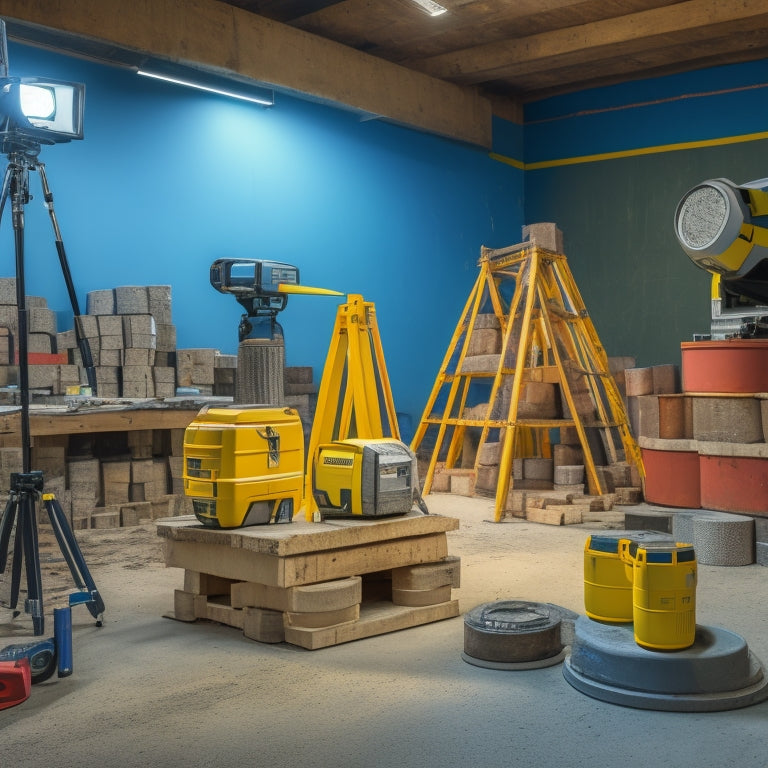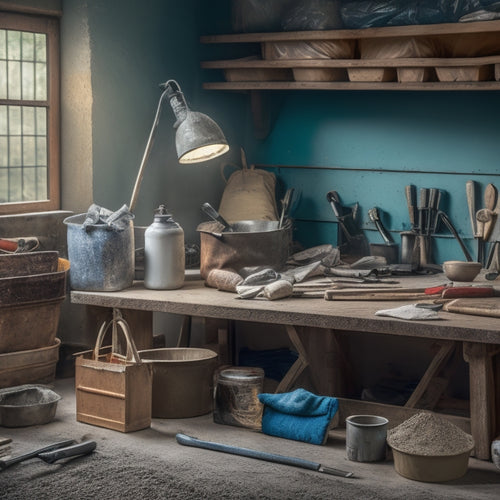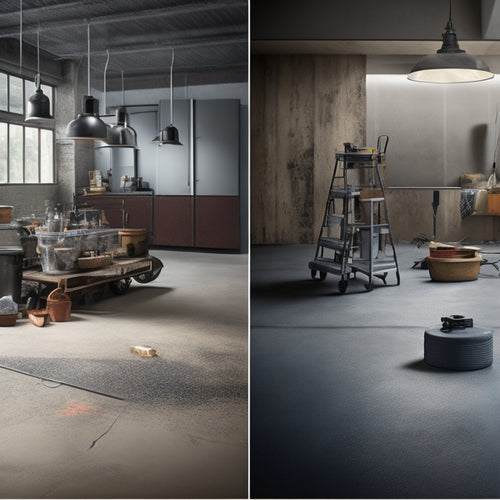
Affordable Tools for Laying Concrete Blocks on a Budget
Share
You can effectively lay concrete blocks on a budget by focusing on essential tools that provide accurate results, without sacrificing quality or breaking the bank. Start with leveling tools like a spirit level, laser level, and string line to guarantee blocks are perfectly aligned. A trowel and pointing tools are must-haves for mortar application, while a mixing bucket and durable equipment will make the process smoother. By prioritizing these affordable tools, you'll be well on your way to a successful concrete block project. Now, discover more ways to optimize your budget and workflow.
Key Takeaways
• Utilize DIY solutions, recycled tools, and tool rentals to reduce costs and stay within budget for concrete block laying projects.
• Invest in essential tools like trowels, mixing buckets, and levels that provide long-term value and durability.
• Opt for affordable alternatives like using a spirit level instead of a laser level for accurate measurements.
• Practice and master block laying techniques to minimize waste and reduce the need for expensive equipment.
• Consider eco-friendly approaches like repurposing materials to reduce waste and save costs on concrete block laying tools.
Essential Cinder Block Laying Tools
You'll need a few essential tools to get started with laying concrete blocks, including a level, a string line, and a trowel. These tools will help you achieve professional-looking results and guarantee your blocks are laid straight and level.
When it comes to block laying techniques, having the right tools can make all the difference. For instance, a level will help you check the accuracy of your block placement, while a string line will guide you in maintaining a straight course.
When choosing cinder block types, consider the specific needs of your project. Are you building a retaining wall or a decorative feature? Different block types are suited to different applications, so make sure you select the right one for the job.
With the right tools and blocks, you'll be well on your way to mastering block laying techniques. Remember, practice makes perfect, so don't be discouraged if it takes a few tries to get the hang of it. With patience and persistence, you'll be laying concrete blocks like a pro in no time.
Budget-Friendly Tool Alternatives
Three budget-friendly alternatives to expensive tools are available for laying concrete blocks, providing a cost-effective solution for DIY enthusiasts and professionals alike.
You can opt for DIY cinder solutions that utilize everyday items, such as using an old broom handle as a level or a bucket as a mixing container. These creative solutions not only save you money but also reduce waste.
Another alternative is to explore recycled tool options. You can repurpose old tools or purchase second-hand tools from online marketplaces or local hardware stores. This eco-friendly approach not only reduces waste but also helps you stay within your budget.
Additionally, consider renting tools instead of buying them. Many hardware stores offer tool rental services, which can be a cost-effective solution for one-time projects.
Concrete Block Handling Equipment
When it comes to concrete block handling equipment, you'll want to contemplate tools that make the job easier and safer.
You'll need devices that can securely lift and move blocks into place, and that's where block lifting attachments and concrete block clamps come in.
Block Lifting Attachments
Lifting concrete blocks into place can be a backbreaking task, but with the right block lifting attachments, you can reduce the physical strain and increase your productivity. By incorporating efficient block lifting techniques into your workflow, you'll be able to complete projects faster and with less fatigue. It's essential to prioritize lifting safety, as improper lifting can lead to injuries and accidents on the job site.
When selecting block lifting attachments, consider the weight and size of the blocks you'll be working with, as well as the terrain and obstacles on your job site. Look for attachments that are designed for ergonomic lifting, with comfortable grips and adjustable straps.
Some attachments also feature built-in safety features, such as load limiters or automatic slack adjusters, to guarantee that you're lifting within safe parameters. By investing in the right block lifting attachments, you'll be able to work smarter, not harder, and achieve professional results without breaking the bank.
Concrete Block Clamps
You'll find concrete block clamps to be an essential component of your concrete block handling equipment, providing a secure grip on blocks to guarantee safe and efficient transport around the job site.
Whether you're working with standard concrete blocks, insulated concrete blocks, or even decorative blocks, clamps are a must-have tool. They prevent blocks from shifting or falling during transport, ensuring you can focus on perfecting your block laying techniques.
Here are some key benefits of using concrete block clamps:
-
Versatility: Clamps can be used with various concrete block types and sizes, making them a valuable addition to your toolkit.
-
Time-saving: By securely holding blocks in place, clamps reduce the time spent repositioning or rehandling blocks, allowing you to complete your project more efficiently.
-
Injury prevention: Clamps minimize the risk of accidents caused by blocks falling or shifting during transport, creating a safer work environment for you and your team.
Efficient Block Moving
With concrete block clamps securely holding your blocks in place, it's time to focus on efficiently moving them around the job site with the right concrete block handling equipment.
You'll want to invest in tools that streamline your block moving techniques, saving you time and energy. A block cart or dolly is a must-have for transporting heavy blocks across the site. Look for one with sturdy wheels and a durable frame that can withstand the weight of your blocks.
For more precise control, consider a block handler or gripper, which allows you to lift and move individual blocks with ease. By incorporating these tools into your workflow, you'll create efficient workspaces that reduce congestion and improve productivity.
Remember to choose equipment that's durable, reliable, and easy to maintain to guarantee your block-laying project stays on track.
With the right concrete block handling equipment, you'll be able to move blocks quickly and safely, allowing you to focus on the quality of your work.
Leveling and Alignment Tools
When laying concrete blocks, you'll need to verify they're perfectly level and aligned.
To achieve this, you'll need the right tools to get the job done accurately and efficiently.
You'll want to contemplate investing in a reliable spirit level and a laser level to guarantee precision in your work.
Spirit Level Essentials
Accurate leveling and alignment are crucial steps in laying concrete blocks, and a spirit level is an essential tool for achieving these critical tasks. When it comes to spirit levels, you'll find various types on the market, each with its unique features and benefits. For instance, you can opt for a traditional bubble spirit level, a digital spirit level, or a combination of both.
Here are three key factors to keep in mind when choosing a spirit level:
-
Spirit level accuracy: Look for a spirit level with high accuracy, typically measured in degrees or fractions of a degree. A higher accuracy guarantees that your blocks are perfectly level and plumb.
-
Durability and build quality: A spirit level is a tool that's often subjected to rough handling and harsh job site conditions. Choose a level with a rugged build and durable materials to withstand the demands of your project.
-
Ease of use and readability: Opt for a spirit level with clear, easy-to-read markings and a comfortable design that makes it easy to handle and maneuver.
Laser Level Precision
You can take your leveling and alignment tasks to the next level by incorporating a laser level into your toolkit, which offers unparalleled precision and efficiency. This innovative tool allows you to achieve accurate measurements and alignments with ease, saving you time and effort.
One of the significant laser level benefits is its ability to project a level line or dot onto a surface, ensuring that your blocks are perfectly aligned. This eliminates the need for manual measurements and reduces the risk of errors.
With a laser level, you can achieve laser level accuracy of up to 1/16 of an inch, making it an essential tool for any concrete block laying project. Additionally, laser levels are often self-leveling, which means they can automatically adjust to the surrounding environment, providing you with accurate readings even on uneven surfaces.
Mortar Mixing and Application
Mixing mortar to the right consistency is essential for a strong, long-lasting block structure, so get it right by following a few simple guidelines. You'll want to achieve a mix that's not too runny or too thick. Here are some mortar consistency tips to keep in mind:
-
Start with the right ratio of cement to sand, usually 1:3 or 1:4, and adjust as needed.
-
Add water gradually, mixing thoroughly between additions, until you reach the desired consistency.
-
Test the mix by squeezing a small amount between your thumb and index finger; it should hold its shape and not crumble.
When it comes to mixing techniques, remember to:
-
Use a mixing bucket with a sturdy handle and a non-slip bottom to prevent spills and accidents.
-
Mix in small batches to maintain consistency and avoid wasting materials.
-
Use a mixing stick or trowel to scrape the sides and bottom of the bucket, ensuring all ingredients are well incorporated.
Safety Gear for Concrete Work
As you move from mixing mortar to laying concrete blocks, don't forget to gear up with the right safety equipment to protect yourself from the physical demands and hazards of concrete work. Concrete work can be physically demanding, and the materials involved can be hazardous to your health if not handled properly.
To guarantee your safety, it is crucial to wear the right personal protective equipment (PPE). Here's a breakdown of the must-haves:
| Safety Gear | Purpose |
|---|---|
| Hard hat | Protects your head from falling objects |
| Safety glasses | Shields your eyes from debris and dust |
| Dust mask | Provides proper ventilation and filters out airborne particles |
| Gloves | Protects your hands from cuts, abrasions, and chemicals |
| Steel-toed boots | Safeguards your feet from heavy objects and tools |
Frequently Asked Questions
Can I Use a Regular Shovel for Mixing and Applying Mortar?
You can use a regular shovel for mixing mortar, but it's not ideal; consider a square-edged shovel or a mortar hoe for more efficient mixing and applying, especially for larger projects.
Do I Need a Permit to Lay Concrete Blocks on My Property?
You'll need to check your local building codes and property line considerations to determine if a permit is required to lay concrete blocks on your property; it's crucial to guarantee compliance to avoid costly fines or project shutdowns.
Can I Lay Concrete Blocks in the Rain or During Winter?
'Imagine trying to build a castle on a soggy foundation - it's a recipe for disaster. You shouldn't lay concrete blocks in the rain, as it'll weaken the bond between blocks and mortar. Take winter precautions, like covering your work area, to guarantee a solid structure.'
How Do I Clean and Maintain My Concrete Block Laying Tools?
You'll extend the life of your tools by storing them properly and using effective cleaning methods, like wire brushing and soap solutions, to remove cement residue, ensuring they're ready for your next project.
Can I Use Second-Hand or Borrowed Tools for Concrete Block Laying?
'Will you really get the job done efficiently with subpar tools? Probably not. You can use second-hand or borrowed tools, but prioritize essential ones, and weigh tool selection against cost savings to guarantee a successful concrete block laying project.'
Conclusion
You've made it to the final brick in the wall - literally!
Laying concrete blocks on a budget doesn't have to mean sacrificing quality for cost.
With these affordable tools, you'll be building like the Great Pyramid of Giza in no time.
Remember, a strong foundation is key, and with the right tools, you'll be able to construct a structure that'll stand the test of time.
Now, get building and make your concrete dreams a reality!
Related Posts
-

10 Must-Have Tools for Small Concrete Projects
When tackling small concrete projects, you'll need a range of essential tools to achieve professional-grade results. ...
-

Top Tools for Revamping Old Concrete Floors
You'll need a range of tools to revamp your old concrete floor, starting with epoxy, acrylic, or polyurethane paint, ...
-

10 Best Tools for Sealed Concrete Finishing Success
When it comes to sealed concrete finishing success, you need a robust arsenal of specialized tools. Start with essent...


